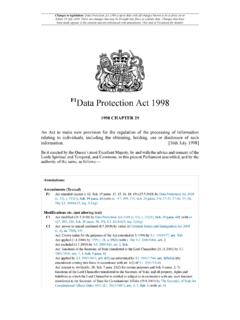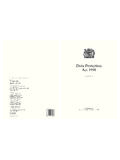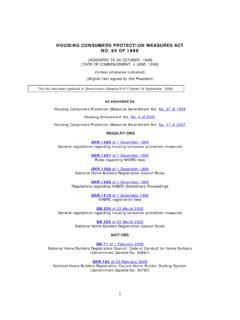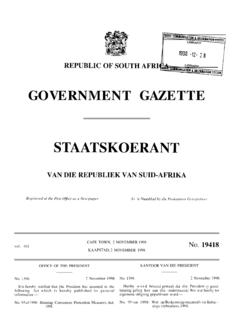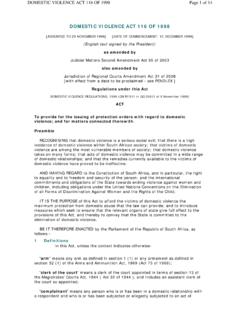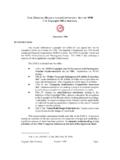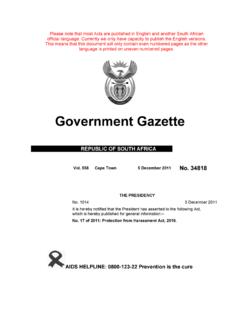Transcription of GAP 37: Guidance on the data protection Act 1998 December …
1 1 GAP 37: Guidance ON THE data protection ACT 1998 December 2004 Summary This GAP explains the requirements of the data protection Act 1998 (The Act), which aims to protect the rights and privacy of individuals. HSE holds a considerable amount of personal data : for certain duty holders, members of the public, and staff. In order to use this personal information fairly and legitimately, HSE must also adhere to certain principles & conditions and to the specified rights of the individual. This GAP replaces all previous instructions on data protection . It presents up to date Whitehall-wide advice and emphasises our practical experience of the Act. 2 CONTENTS 4 PURPOSE OF THIS 4 EXECUTIVE 5 THE 8 data protection RIGHTS .. 8 TERMS AND 10 16 INTRODUCTION TO EXEMPTIONS FROM data protection 17 PROACTIVE 21 21 data protection 21 CONDITIONS FOR PROCESSING PERSONAL 25 CONDITIONS FOR PROCESSING SENSITIVE PERSONAL 26 PROACTIVE DUTY TO INFORM data 27 NOTIFICATION TO THE INFORMATION 28 data 29 REACTIVE DUTIES PART 1 SUBJECT 30 30 SUBJECT ACCESS WHAT THE LAW 30 REQUESTS MADE IN A LANGUAGE OTHER THAN 32 Exemptions to subject access 33 CONSULTING OTHER data 38 38 DISCLOSURE OF PERSONAL data TO THIRD 41 41 ENVIRONMENTAL INFORMATION REGULATIONS 42 DISCLOSURE OF NAMES OF 43 DISCLOSURE OF POSTHOLDER 43 REQUESTS FROM A data SUBJECT S 44 NON-DISCLOSURE TO THIRD 45 DISCLOSURE TO THIRD PARTIES & THE data protection PRINCIPLES46 EXEMPTIONS TO THE NON-DISCLOSURE PROVISIONS COVERING THIRD PARTY 47 49 3 REACTIVE DUTIES PART 2 - OTHER 49 49 RIGHT TO PREVENT PROCESSING THAT WOULD CAUSE DAMAGE OR 49 RIGHT TO PREVENT PROCESSING
2 FOR DIRECT MARKETING 50 RIGHTS IN RELATION TO AUTOMATED 51 RIGHT TO HAVE INACCURATE data RECTIFIED, BLOCKED, ERASED OR 51 DISCLOSURE FOR THE PURPOSES OF LEGAL 55 55 SUBJECT ACCESS AND LEGAL 55 REFUSALS AND COURT ORDERS IN RESPECT OF LEGAL PROCEEDINGS56 ANNEX 57 WHAT TO DO IF YOU RECEIVE A SUBJECT ACCESS 57 ANNEX 60 MODEL REPLY TO A SUBJECT ACCESS 60 ANNEX 62 MODEL LETTER SEEKING FURTHER INFORMATION/PROOF OF IDENTITY FOR OPEN-ENDED 62 ANNEX 63 SUBJECT ACCESS - REDACTING (EDITING) OR EXTRACTING 63 ANNEX 65 DEFAMATION: LIBEL & 65 ANNEX 67 BREACH OF 67 ANNEX 68 THE HUMAN RIGHTS 68 ANNEX 71 data SHARING CASE 71 ANNEX 73 TRANSFERRING PERSONAL data OUTSIDE THE EUROPEAN ECONOMIC AREA (SCHEDULES 1 AND 4 OF THE ACT).. 73 4 SECTION 1 INTRODUCTION PURPOSE OF THIS GAP 1. In 1998 , the HSE Board decided to delegate day to day responsibility for compliance with the 1998 Act to Directorates and Divisions, as they are best placed to understand their locally held personal data and how the Act will affect them.
3 2. Some staff are designated as Directorate or Divisional data protection contacts and you should find out who that is in your own Directorate or Division. This GAP is designed primarily for them to help advise you on data protection compliance but you are free to read it or refer to it at any time. A less detailed introduction to the data protection Act is available on the intranet. You should go to your local contact whenever you have a question about data protection in the first instance. 3. The Board does not expect either your local contact or you to be experts on data protection but as all of us, potentially, have responsibilities under the 1998 Act it is important for each of us to know when the 1998 Act is likely to apply and what we will need to do when it does. 4. This GAP provides enough information for contacts to advise you in most data protection cases. 5. The purpose of this GAP is to: explain some of the terms used in the 1998 Act; explain the requirements on HSE staff; and to indicate central and Directorate/Divisional roles in achieving continuous compliance.
4 6. This GAP applies to: y HSC/E s dealings with the public regarding data protection ; and y HSC/E staff: where the detail in the GAP is relevant to HSC/E staff and their data protection rights as individual citizens in relation to the personal data that HSC/E holds on them ( access to certain personnel and payroll records), appropriate Guidance appears in the relevant section. Supplementary Guidance can be found in Chapter 12 of the HSE Staff Handbook. 5 Note: the Information Commissioner has published the Employment Practices data protection Code in several parts. The Code is intended to explain to both employers and employees how the data protection Act 1998 might affect them. The Code is available from the Information Commissioner s website. You are free to read the Code. However, please refer to Chapter 12 of the HSE Staff Handbook and, if necessary, to Personnel Division, if you have any data protection questions relating to you as a member of staff.
5 7. The Cabinet Office has issued Guidance calling for departments to ensure that their personnel records keeping practices are compliant with the Act. HSE applies the Guidance to its personnel practices affected by the Act. Personnel Division holds a copy of this Guidance which is also available on the Cabinet Office website. 8. This GAP provides advice on how the provisions apply to the personal information that HSE holds. Directorates and Divisions should follow the advice and instructions set out below unless advised to do otherwise by either the Information Management Unit (IMU) or the Solicitor s Office. What is not covered by this GAP 9. This GAP does not provide prescriptive advice on specific data protection issues. While the advice that appears here can be used to guide Directorates and Divisions in complying with the 1998 Act for most situations likely to arise in HSE, it is neither possible nor desirable to provide prescriptive advice.
6 10. Neither does this GAP provide detail legal advice on compliance with the Act. If your case or circumstances are not covered in this Guidance you should approach your Directorate or Divisional data protection contact in the first instance. In such cases, remember to think through all the issues involved before you reply in full. 11. The IMU and the Solicitor s Office should only be contacted in cases of genuine complexity. EXECUTIVE SUMMARY 12. Staff should be aware that they should ask their Directorate or Divisional data protection /Open Government Contact for clarification and advice as necessary. 13. This GAP explains the requirements of the Act on HSE staff. This Act replaces the data protection Act 1984 and seeks to protect people s privacy with respect to information that organisations hold about them. The Act calls this personal data . In HSE we hold many types of personal data . These include: F2508 accident report forms; some mailing lists containing names and addresses; parts of FOCUS entries; 6 qualifications databases ( certificates of diving competence); safety policies of sole traders; some registers of correspondence.
7 14. The 1998 Act covers information held manually, on computer and in a relevant filing system . The Act covers all personal data that we have already collected and all that we will collect in the future. The Act requires that we in HSE recognise and understand its key elements. These elements include: its wide scope, including sets of manual personal data , information held in a highly structured (and for public authorities, unstructured) form as well as computerised data ; the required adherence to the 8 data protection principles and the conditions of processing 1 (see paragraphs 78-103); a restriction on the transfer of personal data to countries that do not have adequate security2 (see paragraph 97); appropriate security measures to safeguard personal data3 (see paragraph 103); the rights for the data subject4 (see paragraph 92); provision for enforcement where the Act's provisions are not carried out5 (see paragraphs 22-23); certain exemptions from the provisions6 (see paragraphs 60-74); and a restriction on the disclosure of personal data to others7 (see paragraphs 207-210).
8 15. In preparation for the Act s implementation, Directorates and Divisions compiled local plans to implement the Act for the personal data that they have responsibility for. These, together with the Guidance in this GAP, should continue to identify the most cost-effective ways of complying with the provisions of the 1998 Act. 7 Important note 16. It is particularly important to realize that, apart from certain exemptions to certain duties, all existing statutory restrictions on access to personal data - such as section 28 of the Health and Safety at Work etc Act 1974 (HSWA) - are disapplied in respect of the data subject, but not in respect of third parties8. Please see GAP 1 (Ed Note: Link to Annex 2, para 32, GAP 1) if you are not familiar with section 28 of HSWA in this GAP. 1 Section 4(1), (2), (3), (4) of, and Schedule 1, parts I & II of the 1998 Act 2 Section 4 (1) and (2) of, and Schedule 1, part I, para 8, and Schedule 1, part II, paras 13-15 3 See part III of the 1998 Act 4 See part II of the 1998 Act 5 See part V of the 1998 Act 6 See part IV of the 1998 Act 7 Sections 4(1), (2), 7 (3), (4), (6) and 27 (3) of the 1998 Act 8 SECTION 2 THE BASICS WHAT IS IN THIS SECTION?
9 data protection Rights Terms & Definitions Manual Records E-mail Exemptions from DP duties data protection RIGHTS 17. The purpose of both the 1998 Act and the EC Directive1 to which the Act gives effect, is to protect the fundamental rights and freedoms of living individuals, and in particular their right to privacy with respect to the processing of their personal data whilst facilitating the free movement of data between member states by the legitimate processing of personal data by data controllers. It is a reserved issue and applies equally throughout the United Kingdom (UK). 18. The Act accords individuals certain rights regarding the personal data or sensitive personal data held on them. These are: A right of access to personal information held on them (subject access)2. 19. data subjects have the following subject access rights (subject to the exemptions in paragraphs 147-189 below) upon providing a written request and supplying the information - detailed at paragraphs 129-146 - that HSE is entitled to request to enable us to search for the data : the right to seek confirmation that we hold personal data on them or that such data are held by a third party on our behalf ( National Radiological protection Board as our nominated data processor for certain radiation data ); if we hold personal data relating to them, data subjects have the right: to be given a description of the data ; to be informed of the purposes for which we are processing the data ; to be informed of the categories of recipient to whom we may disclose the data ; 9to be informed whether any automated processing we do will form the sole means of taking decisions significantly affecting them.
10 And if the data subjects so wish, they have the right: to be given a copy of the data in an intelligible form ( with an explanation of codes, abbreviations etc. used, and with sufficient extra information to allow the individual to make sense of their personal data ; in an accident investigation report it is insufficient to provide only the sentences on Mr Smith - you should also include the sentences dealing with circumstances around the accident without mentioning any other person involved); and to be given any information we hold on the source of the data (see paragraphs 106-111 on HSE s Notification). A right to prevent processing likely to cause the data subject, or another, damage or distress3. A right to prevent processing for the purposes of direct marketing4. A right not to have certain decisions made about them, which are based solely on automated processing5. A right to claim compensation where the Act s requirements have been contravened6.










